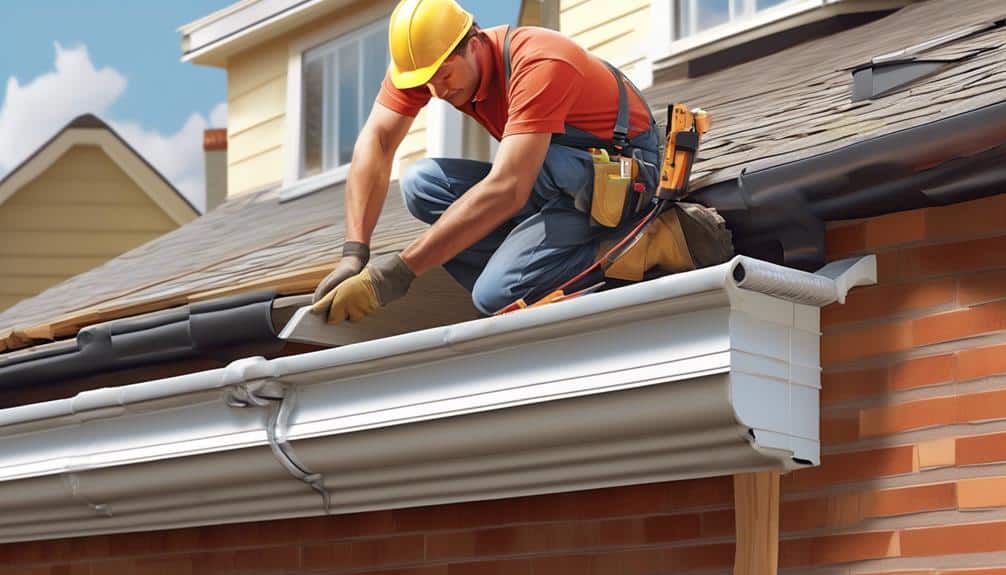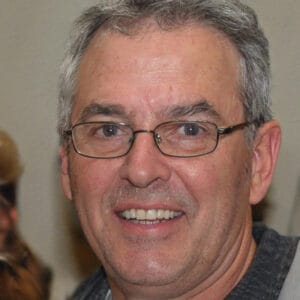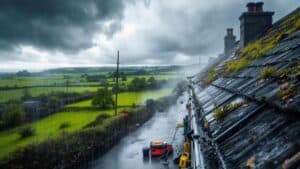Table of Contents
ToggleHow effectively do your gutters and downspouts shield your home from water damage? These critical components work together to channel rainwater away from your foundation, preventing costly structural damage and landscape erosion.
At Guttering Services, we install and maintain complete drainage systems throughout Limerick and Clare. Properly sized and installed gutters collect water from your roof while strategically placed downspouts direct this water safely away from your property, creating a defence system against Ireland’s frequent rainfall.
This comprehensive guide explains how to determine if your current system provides adequate protection, signs of failure that require immediate attention, and how our professional solutions prevent expensive water damage.
Contact Guttering Services today for a free inspection of your gutters and downspouts to ensure your property remains protected from water damage year-round.
Key Takeaways
- Gutters and downspouts are essential components of a building’s water management system, diverting rainfall to prevent structural damage.
- Gutters collect water from the roofline, while downspouts are vertical pipes that funnel this water away from the building.
- The number, placement, and material of gutters and downspouts affect their cost, effectiveness, and lifespan.
- Regular maintenance and proper installation are critical to extending the lifespan of gutters and downspouts, which can vary significantly based on the material used.
What Are the Types of Gutters and Downspouts?
Firstly, let’s talk about materials. The top picks are typically aluminium, vinyl, steel, or copper. Now, aluminium gutters are the go-to for many because they’re light, tough, and won’t rust. Vinyl gutters, on the flip side, are budget-friendly and a breeze to install, not to mention they’re pretty low maintenance. Steel gutters? They’re all about strength and longevity, but keep in mind they may need a regular dose of TLC to keep rust at bay. Lastly, there are copper gutters. These add a beautiful aesthetic touch and are built to last – we’re talking a century here!
Next up, let’s discuss where to place the downspouts. Factors like the roof’s slope, the landscape, and the intensity of rainfall all play a role. The goal is to ensure water drains properly to avoid damaging the foundation. The corners of the building are usually a good spot, as they promote efficient water flow. But don’t forget to extend the downspouts away from the foundation – downspout extensions or splash blocks can be handy to help divert water away from the building.
How Much Do Gutters Cost in Ireland?
In the capital city of Ireland, Dublin, the cost involved in gutter installation and replacement varies significantly, typically ranging from €600 to €1,500. However, the actual price can be influenced by several factors, including the choice of material, the size of the home, and the complexity of the installation.
- Complexity of Installation: The cost can also fluctuate based on the complexity of the job. For instance, a home with many corners or unusual architecture might require customized guttering, thus pushing up the price.
- Material: The choice of gutter material greatly impacts the cost. PVC, the most affordable option, costs between €50 and €100 per linear meter. Aluminium gutters, which are more durable yet still reasonably priced, range from €100 to €200 per linear meter. Finally, for high-end homes, copper gutters can cost anywhere from €300 to €600 per linear meter.
- Size of the Home: A larger home requires more materials and labour, which increases costs. For instance, a two-story home would require more guttering and downspouts compared to a single-story home.
What is the Proper Installation Techniques?

If you want your gutters and downspouts to work like a charm and stand the test of time, it’s crucial to install them correctly. Let me walk you through some handy tips:
First up, make sure you slope your gutters just right. Many folks don’t get this part correct. You see, your gutters need a tiny downward tilt towards the downspouts, about a quarter-inch for every 10 feet. That way, water will glide along easily without causing any overflow or pooling.
Next, you’ve got to make sure your gutters are attached securely to the fascia board. Using sturdy hangers or brackets about 24 to 36 inches apart will do the trick. But remember, don’t tighten those screws too much, as that could damage your gutters.
Here’s another crucial step – sealing the joints effectively. We all know that leaky joints can lead to water damage on your home’s exterior, right? So, go ahead and apply a top-quality silicone-based sealant to create a watertight bond between your gutter sections, end caps, and corners.
Lastly, think about where you’re installing your downspouts. Space them out evenly, about every 30 to 40 feet, and make sure they’re not positioned over walkways or driveways. You don’t want any water buildup or accidents, do you? Consider adding extensions to steer water away from your house’s foundation.
How Many Downspouts Should a Gutter Have?
While considering the cost and installation of gutters, it’s equally important to determine the number of downspouts required for effective water management. The number of downspouts needed is contingent on several factors, including the length of the gutter, your geographic location, and the pitch of your roof.
As a general guideline, one downspout should be installed for every 20-30 feet of gutter. This ratio ensures effective drainage, preventing water from overflowing and damaging your property. However, this rule isn’t absolute. For instance, if your area experiences heavy rainfall or if your roof has a steep pitch, you might need additional downspouts to handle the increased volume of water flow.
The ultimate goal is to maintain a gutter and downspout system that can handle the heaviest rainfall in your region, protecting your home’s foundation from water damage. Therefore, when designing your gutter system, careful consideration should be given to the placement and number of downspouts. Remember, an efficient gutter system is not just about the gutters themselves, but also about how effectively the downspouts can drain the water away.
What Is the Difference Between a Gutter and a Spout?
To grasp the distinction between gutters and downspouts (commonly referred to as ‘spouts’), it’s crucial to comprehend their unique roles in a comprehensive roof drainage system. Gutters and spouts form a symbiotic relationship, with each performing a specific function that contributes to the overall effectiveness of the system.
- Gutters are installed along the roofline. Their primary role is to collect water that runs off the roof during rainstorms. They are designed to run horizontally, parallel to the ground, and effectively act as channels that direct water towards the downspouts.
- Downspouts, on the other hand, are vertical structures affixed to the side of a building. These are essentially pipes that serve as conduits for the water collected by the gutters, allowing it to be safely drained away from the building’s foundation.
- The main difference between gutters and spouts lies in their orientation and function. While gutters collect and channel rainwater, downspouts are responsible for carrying this water away from the house to prevent water damage.
Understanding this distinction is essential for the effective maintenance and operation of a roof drainage system.
What Are the Most Common Issues?

Taking care of your gutters and downspouts is no small task, and understanding how to fix everyday issues can save you a lot of hassle down the road.
Let’s dive into a couple of common problems that might pop up with your gutters and downspouts:
- Leaky gutters: Have you spotted water seeping from your gutters? There could be several causes behind the leaky gutters, such as faulty gutter joints, punctures or cracks in the gutters, or even gutters choked up with debris disrupting the water flow. The best way to tackle this is to give your gutters a good look-over for any visible damage and fix or swap out any damaged parts. Plus, keeping your gutters clean and clear of debris will ensure the smooth flow of water.
- Blocked downspouts: Blocked downspouts can be a real pain! They can cause water to overflow from the gutters, which could potentially harm your home’s foundation. If you see water not draining correctly from the downspouts, it’s probably due to some sort of blockage. Here’s a handy tip: use a plumber’s snake or even a garden hose to get rid of any debris or blockages in the downspouts. Cleaning your gutters and downspouts regularly can also keep clogging issues at bay.
How Long Should Gutters and Downspouts Last?
Durability is a key factor to consider when installing gutters and downspouts, with their lifespan typically ranging from 20 to 50 years, and potentially even up to 100 years in exceptional cases. The longevity of these crucial components largely depends on the material used, the quality of installation, and the level of maintenance they receive.
| Material | Lifespan |
|---|---|
| Aluminium | 20 to 30 years |
| Steel | 20 to 25 years |
| Copper | 50 to 100 years |
Aluminium gutters, for instance, are known for their durability and resistance to rust, typically lasting 20 to 30 years. Steel gutters, although sturdy, are prone to rust and may last between 20 to 25 years. Copper gutters stand out for their exceptional longevity, potentially lasting between 50 to 100 years.
However, lifespan can be significantly reduced without regular cleaning, inspection, and repair. Blocked gutters can lead to water overflow and damage, thereby shortening their service life. Therefore, to maximise the lifespan of your gutters and downspouts, regular maintenance is crucial. This includes removing debris, checking for cracks or leaks, and ensuring the system is securely attached to your home.
Does Guttering Include Downpipes?
In understanding guttering systems, it’s important to note that downpipes are integral components of the setup. They work in harmony with the gutters to ensure efficient water management from your roof.
Essentially, guttering includes downpipes. Let’s explore this in more detail.
- The Role of Downpipes in Guttering Systems: Downpipes are basically the conduits that carry the water collected by the gutters away from the building’s foundation. They are strategically positioned to direct the flow of water to safe drainage areas. Without them, the water collected by the gutters would overflow and potentially cause damage to the building’s structure.
- Integration of Downpipes: Downpipes and gutters are designed to work together. The gutter collects the rainwater and channels it to the downpipes, which then guide the water safely to the ground.
- Types of Downpipes: Downpipes come in various materials, including PVC, aluminium, and copper, to match the material of the guttering system. The choice of downpipe material can impact the overall durability and efficiency of the guttering system.
How Do Gutter Diverters Help with Rainwater Distribution?
Gutter diverters for rainwater distribution help prevent rainwater from pooling around the foundation of a home. By directing water away from the building, these devices protect the structure from potential water damage. Additionally, gutter diverters ensure that rainwater is evenly distributed across the yard, benefiting plants and soil.
Frequently Asked Questions
The lifespan of guttering systems varies significantly based on material quality, installation expertise, and maintenance frequency. Regular maintenance dramatically extends system longevity by preventing debris accumulation, water stagnation, and joint deterioration. Schedule bi-annual inspections and cleanings to identify minor issues before they compromise your entire drainage system and require costly premature replacement.
Gutter installation regulations vary by location, with requirements often embedded in local building codes rather than standalone legislation. Most jurisdictions mandate minimum gutter sizing, proper drainage away from foundations, and specific installation methods to prevent water damage.
Consult with local building authorities or licensed professionals before installation to ensure compliance with current regulations. Professional installers familiar with local codes can help you avoid costly modifications or potential legal issues while ensuring your system effectively protects your property.
Properly functioning gutters and downspouts serve as your first line of defence against basement flooding by directing water away from your foundation. Without this critical drainage system, rainwater saturates the soil around your foundation, creating hydrostatic pressure that forces water through cracks and into your basement.
Maintain your guttering system with regular cleaning and ensure downspouts extend at least 5-10 feet from your foundation or connect to underground drainage. This simple maintenance prevents thousands in potential water damage repairs while protecting your home’s structural integrity and indoor air quality.
Late fall provides the optimal time for comprehensive gutter cleaning after leaves have fallen but before winter precipitation begins. This timing prevents debris from decomposing in gutters during winter months, when frozen material can block drainage and create ice dams.
Schedule a second cleaning in early spring to remove winter debris and prepare your system for spring rains. Professional cleaning services offer safety advantages and thorough inspection that identifies potential issues before they develop into costly repairs.
Several innovative alternatives to conventional guttering systems offer both functional and aesthetic advantages for modern properties. Rain chains provide visual interest while guiding water to collection points, while rain dispersal systems distribute water across larger areas to prevent erosion.
Drip edges and ground-level drainage channels offer minimalist solutions for certain architectural styles, and rainwater harvesting systems transform runoff into usable water for gardens and non-potable household needs. Consult with drainage professionals to determine which alternative best suits your property’s needs and aesthetic preferences.






